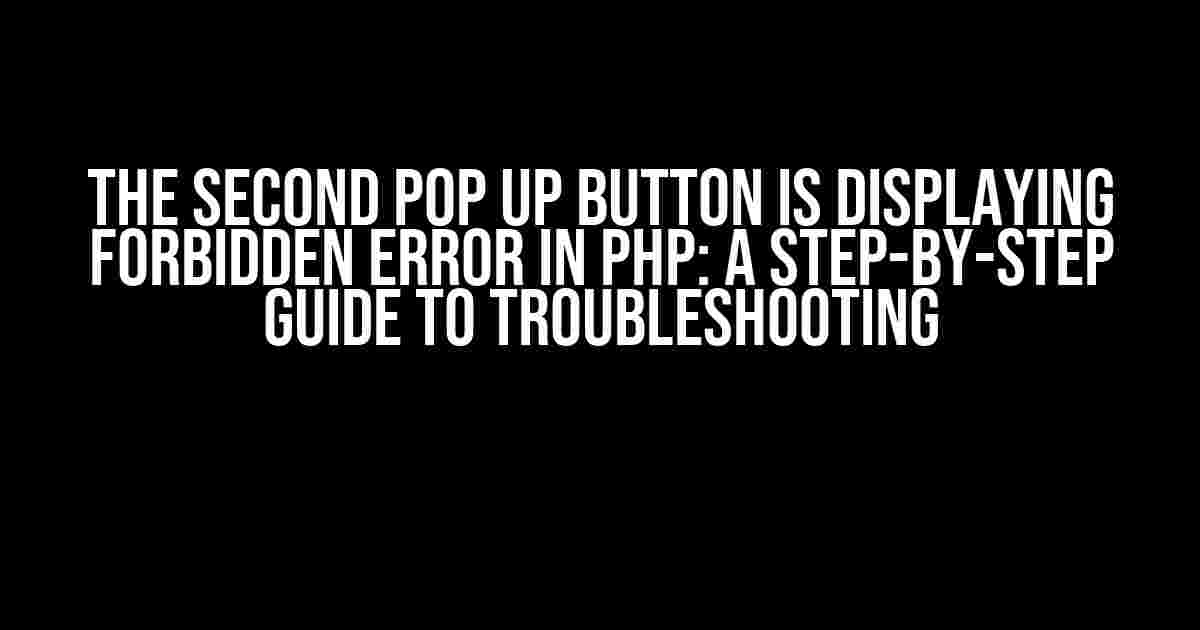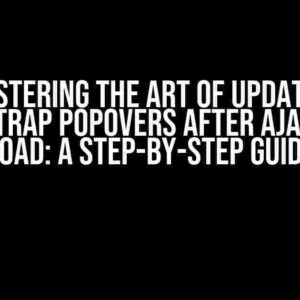Are you experiencing a frustrating issue with your PHP application where the second pop-up button is displaying a “Forbidden Error”? You’re not alone! This pesky problem can be tricky to resolve, but fear not, dear developer, for we’ve got your back. In this comprehensive guide, we’ll walk you through a series of troubleshooting steps to help you identify and fix the issue.
What’s Causing the Forbidden Error?
Before we dive into the solution, let’s understand what’s causing this error. The “Forbidden Error” typically occurs when the server refuses to authorize access to a specific resource. In the context of your PHP application, this error might be triggered by:
- Incorrect file permissions
- Improperly configured server settings
- Invalid or missing htaccess files
- Misconfigured PHP scripts
- Malfunctioning plugins or modules
Step 1: Check File Permissions
One of the most common causes of the Forbidden Error is incorrect file permissions. To resolve this, follow these steps:
- Using an FTP client or file manager, navigate to the directory containing the PHP file that’s triggering the error.
- Right-click on the file and select “Properties” or “Get Info” to view the file permissions.
- Ensure that the file has the correct permissions set. For most PHP files, this should be 755 or 644.
- If the permissions are incorrect, update them accordingly.
Step 2: Verify Server Settings
Next, let’s investigate server settings that might be contributing to the Forbidden Error:
- Check your server’s error logs to see if there are any clues about the issue. You can usually find these logs in the server’s control panel or by using a log analyzer tool.
- Verify that the server is configured to allow PHP files to execute. Check the server’s configuration files (e.g., httpd.conf or php.ini) to ensure that PHP is enabled.
- Ensure that the server’s document root is set correctly. This should point to the directory containing your PHP files.
Step 3: Inspect htaccess Files
htaccess files can sometimes cause conflicts that lead to the Forbidden Error. Let’s investigate:
- Check if there are any .htaccess files in the directory containing the problematic PHP file.
- Verify that the .htaccess file is correctly configured. Look for any syntax errors or misconfigured directives.
- If you find any issues, update the .htaccess file accordingly.
- If you’re using a caching plugin or CDN, try temporarily disabling it to see if it’s interfering with your PHP file.
Step 4: Review PHP Scripts
Sometimes, the issue lies within the PHP script itself. Let’s review the code:
<?php
// Your PHP code here
?>Check the following:
- Verify that the PHP opening and closing tags are correct.
- Ensure that there are no syntax errors or warnings in the code.
- Check for any header or meta tags that might be causing issues.
- If you’re using any PHP frameworks or libraries, ensure they’re up-to-date and correctly configured.
Step 5: Disable Plugins and Modules
Sometimes, a malfunctioning plugin or module can cause the Forbidden Error. Let’s try disabling them:
- Identify any plugins or modules that might be related to the problematic PHP file.
- Temporarily disable each plugin or module, one by one, to see if the error persists.
- If disabling a plugin or module resolves the issue, you’ve found the culprit!
Troubleshooting Table
| Step | Possible Cause | Solution |
|---|---|---|
| 1 | Incorrect file permissions | Update file permissions to 755 or 644 |
| 2 | Improper server settings | Verify server configuration and error logs |
| 3 | Invalid or missing htaccess files | Check and update .htaccess files |
| 4 | Misconfigured PHP scripts | Review PHP code for syntax errors and correct |
| 5 | Malfunctioning plugins or modules | Disable plugins and modules to identify the issue |
Conclusion
By following these steps and troubleshooting the potential causes mentioned above, you should be able to resolve the Forbidden Error issue with your second pop-up button in PHP. Remember to methodically work through each step, and don’t hesitate to seek further assistance if needed.
What’s your experience with the Forbidden Error? Share your own troubleshooting tips and solutions in the comments below!
Additional Resources
For further reading and troubleshooting, be sure to check out these helpful resources:
- PHP Documentation: Error Handling and Logging
- MDN Web Docs: Configuring a Server
- Stack Overflow: PHP Forbidden Error Questions
With persistence and patience, you’ll be able to overcome the Forbidden Error and get your second pop-up button working as intended. Happy coding!
Frequently Asked Questions
Stuck with the infamous “Forbidden Error” on your PHP pop-up button? Don’t worry, we’ve got you covered! Here are some frequently asked questions to help you troubleshoot the issue.
Why is the second pop-up button displaying a Forbidden Error in PHP?
This error usually occurs when there’s a permission issue with the file or directory. Check if the file has the correct permissions and ownership. You can try setting the permission to 755 or 644, depending on your server configuration.
Is the Forbidden Error related to file permissions only?
Not necessarily! The Forbidden Error can also be caused by issues with your PHP script, such as incorrect file paths or incorrect user authentication. Make sure to review your code and check for any syntax errors.
Can the Forbidden Error be caused by a server-side issue?
Absolutely! The Forbidden Error can be caused by server-side issues such as incorrect Apache or Nginx configurations, firewall restrictions, or even a misconfigured SSL certificate. Check your server logs for any errors or issues that might be related to the Forbidden Error.
How can I troubleshoot the Forbidden Error in PHP?
To troubleshoot the Forbidden Error, try enabling error reporting in your PHP script, check the server logs for any errors, and use tools like the PHP debugger or Xdebug to identify the issue. You can also try moving the file to a different location or server to see if the error persists.
Is there a way to avoid the Forbidden Error in the future?
Yes! To avoid the Forbidden Error in the future, make sure to follow best practices for file permissions, ownership, and PHP coding. Regularly update your server software and PHP version, and implement security measures such as input validation and secure file uploads.


